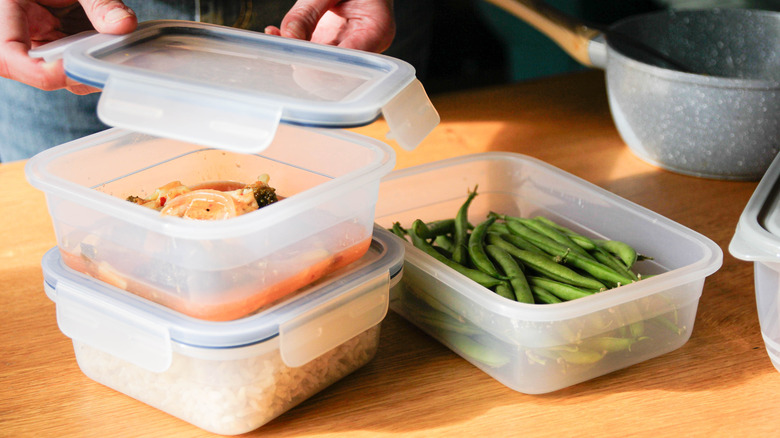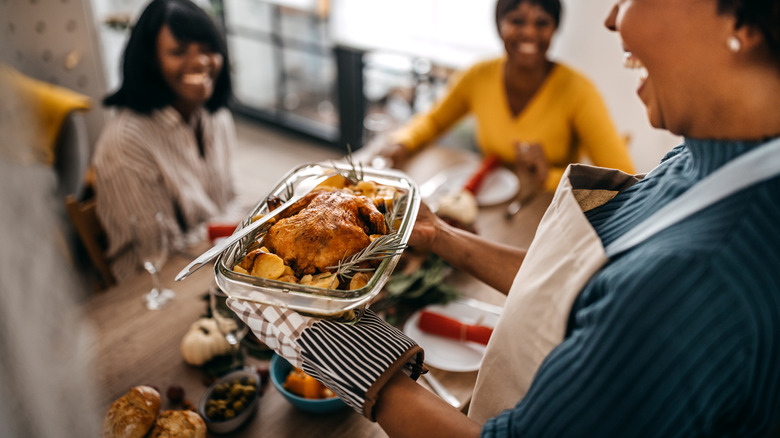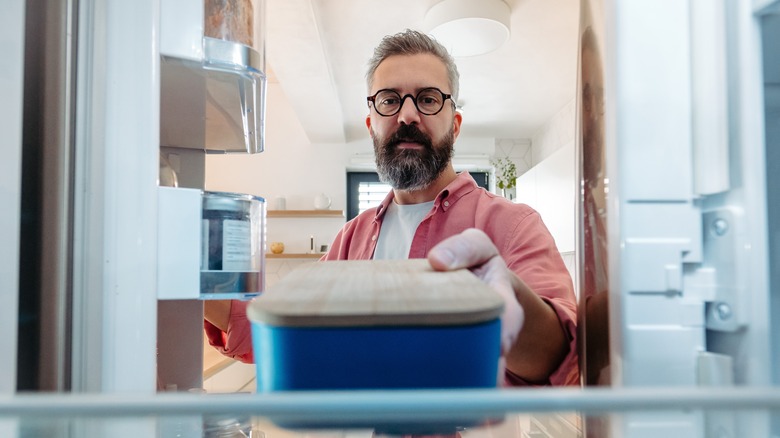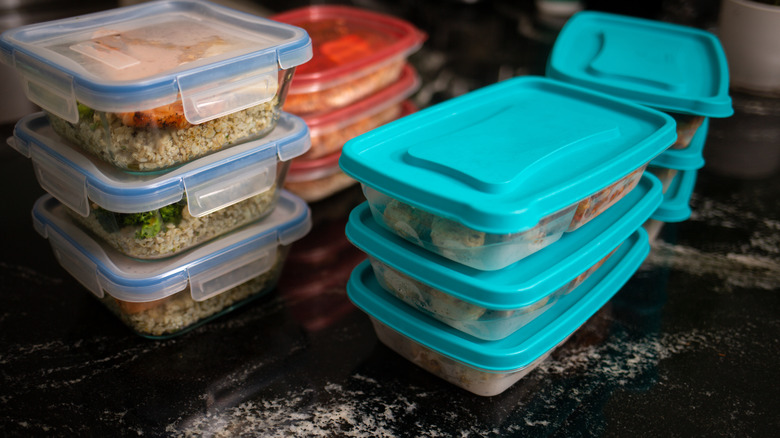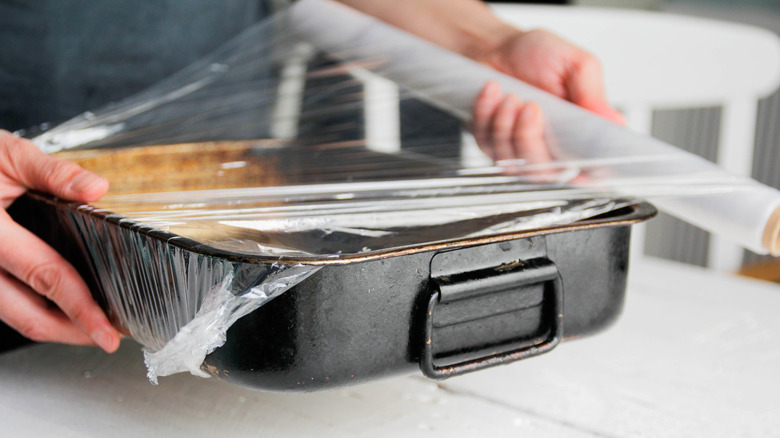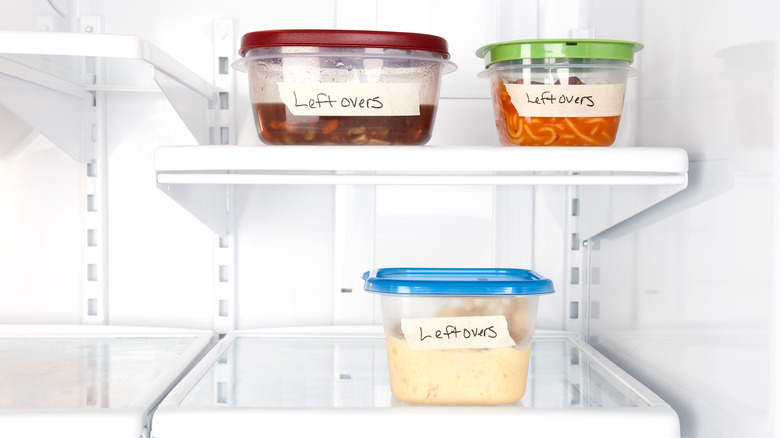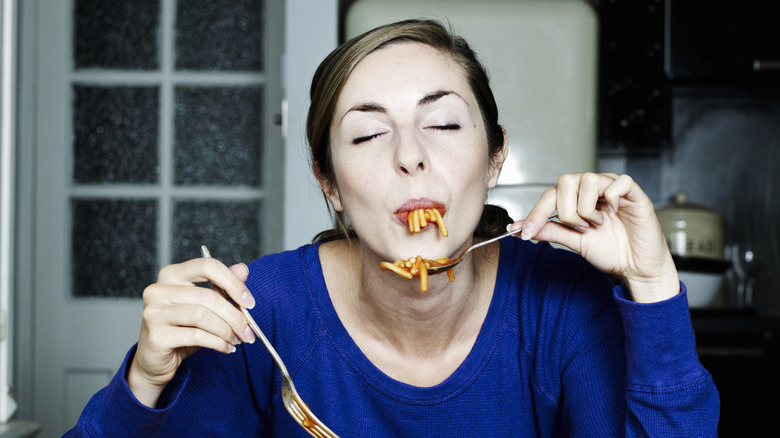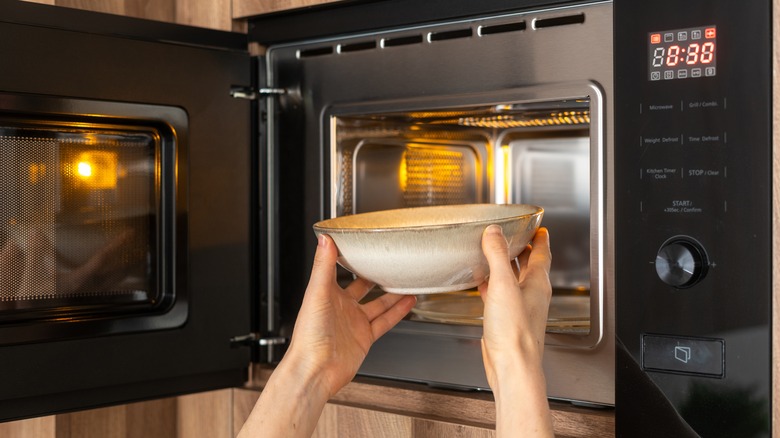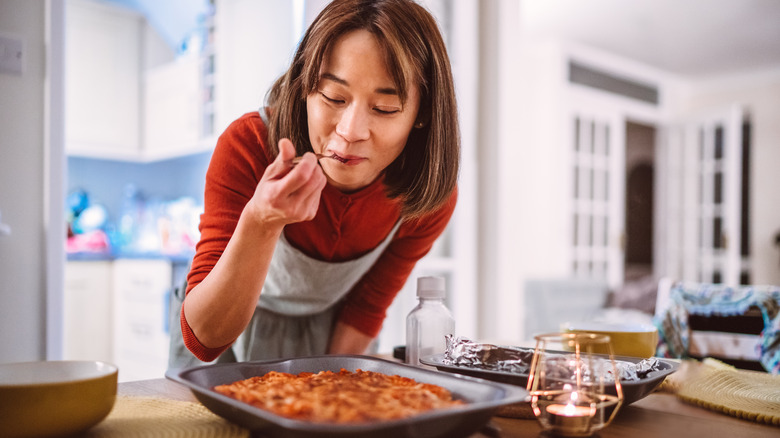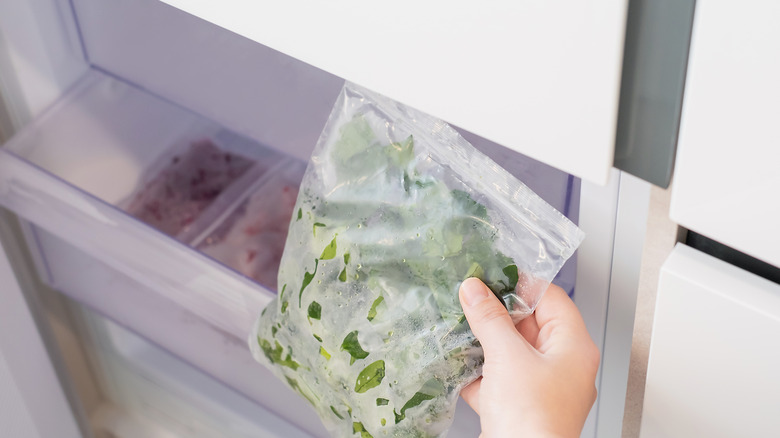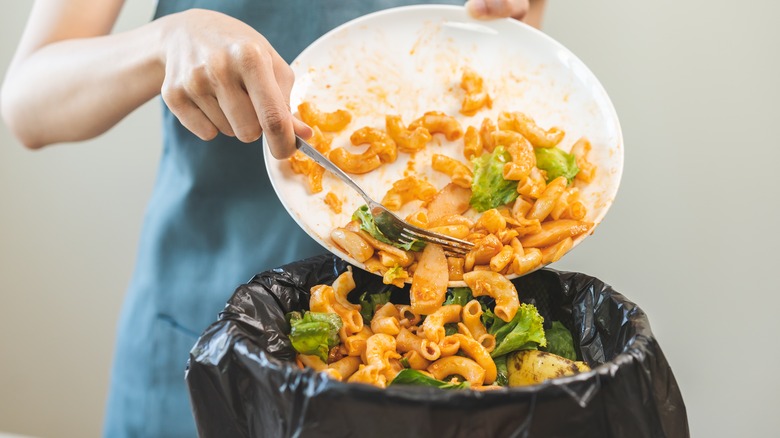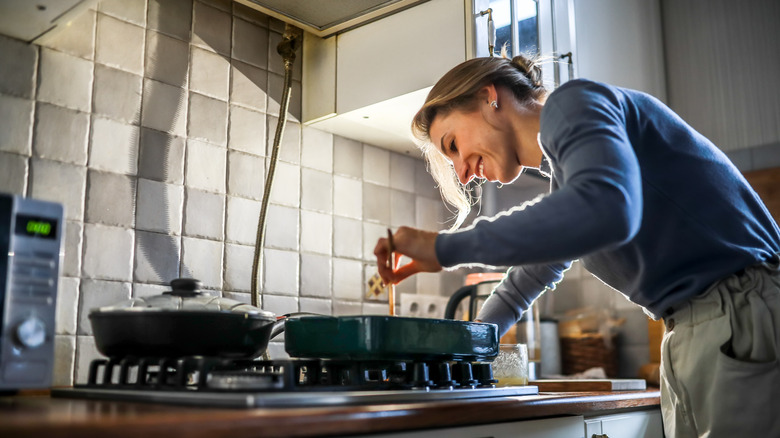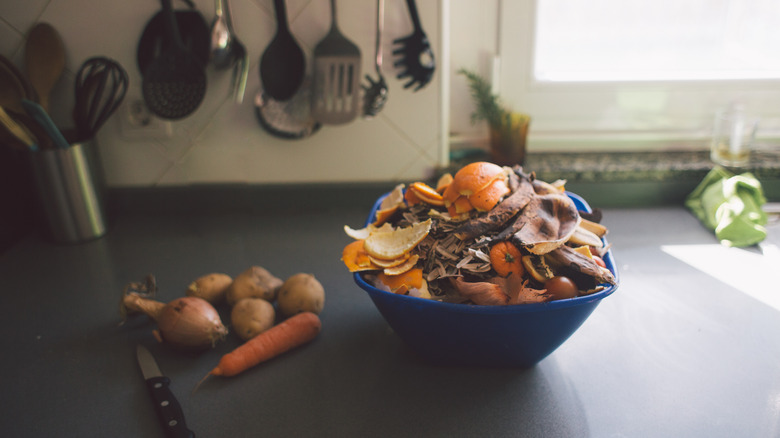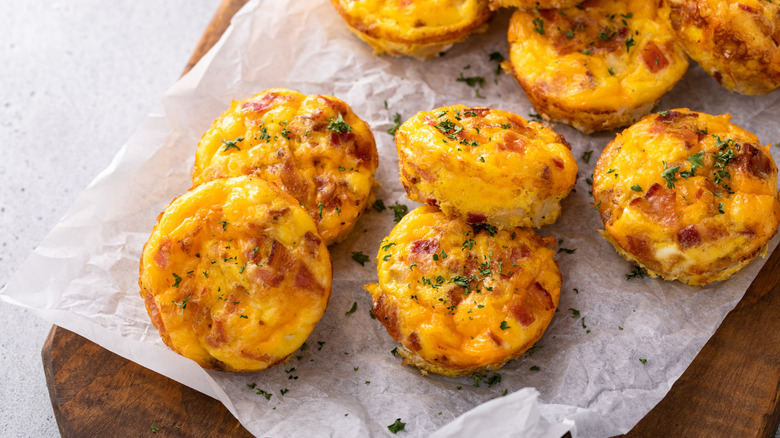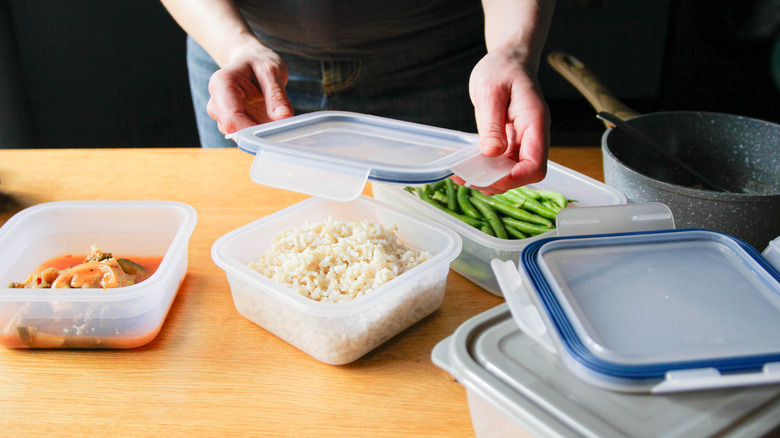14 Mistakes You Are Making With Leftover Food
Is there anything truly as magical as leftovers? Maybe you spent a weekend day making a huge batch of slow-simmered soup, perfect for the chillier season, and now you get to feast on the rewards of your labor for days to come. Maybe you baked up a particular dish that you know always tastes better after a day or two in the fridge, once all the flavors have mixed and melded (from potato salad to hash brown casserole, we all have a few favorites like this). Maybe you cooked up a pot roast or roast chicken for the fam, and now you have the joy of repurposing all the leftovers into brand-new and equally tasty dishes for the week ahead.
Whatever the case may be, whatever the dish, most home cooks love some top-tier leftovers. However, it's all too easy to make a series of equally easily avoidable mistakes regarding your leftover food treatment — mistakes that could not only negatively impact your leftover food's quality, but even potentially make you and your loved ones ill. Here are some of the top mistakes you might be making with your leftover food, and what to do, instead.
Not putting them away fast enough
You've cooked a delicious feast and now you're settling in to tuck in. Between the great food and great conversation, maybe a glass of wine or two, you totally lose track of time. When you finally do clean up and make it back to the kitchen, your leftovers should still be good, right?
Well, not necessarily. According to the U.S. Department of Agriculture (USDA), all leftovers should be properly stowed away within two hours of them being cooked. Once those two hours have passed, it's all too likely that your food will fall into the dreaded "danger zone," or the time period in which food settles in at close to room temperature, allowing bacteria to grow — bacteria that could make you seriously ill.
Make a point to watch the clock after you take any foods off the stove or out of the oven, and ensure they make it into the fridge within two hours. The extra effort will be well worth it, when you're able to safely enjoy your leftovers in the future.
Not cooling items before storing them
So let's say that you successfully put your leftovers into the fridge as soon as humanly possible after cooking your meal. While that's a good start, it is possible that even just popping that food into the fridge isn't enough to prevent the food from entering the bacterial danger zone. Even if the ambient temperature of your fridge is below 40 F, that doesn't mean your food will automatically fall to that temperature once you close the fridge door. Some foods can, in fact, stay so hot, for so long, after entering the fridge, that it allows time for bacteria to grow. This is especially the case with large quantities of food, such as a large casserole, roast, or pot of soup.
To prevent this, you can rapidly cool your food before storing it. Consider using an ice bath or cold water to quickly cool containers of leftovers to a safer temperature.
Not portioning out your leftovers
Portioning out your leftovers will also help them cool faster, ensuring they reach a safe temperature before bacteria can multiple. The USDA recommends portioning leftovers in smaller containers, preferably shallow containers that allow for greater airflow and faster cooling. Cut large servings of meat into smaller portions, even if that means you have to, for example, strip your turkey or chicken of its leftover meat right after dinner (you can keep poultry legs and wings whole, when storing, as these portions are small enough to chill quickly).
However, not only will portioning out your leftovers help prevent dangerous bacterial growth. It can also make reheating easier, later. Have you ever really just wanted a slice of that leftover lasagna for lunch, and you then find yourself sawing away at the cold, tough, refrigerated casserole, all so you can free a small-enough serving? Proportioning leftovers out into smaller servings suitable for future meals, while the food is still hot, makes everything easier.
Using the incorrect storage containers
If you own a hodgepodge of old food storage containers — a mix of takeout containers, maybe an old plastic margarine tub, and a few clear containers long-stained from leftover chili or pasta sauce — you're not alone. It's all too common to amass a haphazard pile of leftover storage containers, stacked precariously in one part of your pantry. However, if you're not taking care to choose the right storage containers, you may be putting your leftovers' quality at risk.
To keep your leftovers tasting great, longer, choose airtight containers or packaging. Again, shallow containers are best, as they allow your food to cool faster, initially. If you want a space-saving solution, consider silicone food storage bags. Planning on putting those leftovers in the freezer? Make sure your air-tight containers or packaging are moisture-proof as well, and look for freezer-safe materials. If you don't, you could just end up with leftovers that are dried out, discolored, and a lot worse for wear.
Not labeling your leftovers
All of your leftovers have been safely stored in your fridge and freezer, and you've followed all the correct precautions, ensuring that your leftovers remain both safe and tasty. However, now you're running into a problem of a different kind. Is that cheese-covered casserole in the back of the fridge the chicken and rice casserole you made last Wednesday, or the hash brown casserole you made four days ago? Is the frosty-looking red stuff in the freezer tomato sauce or strawberry puree? You're not entirely sure what exactly is what, and you're definitely not sure how long it's been in the fridge and, especially unsure about what's sitting in the freezer, where leftovers can linger for months at a time.
The quick and easy fix to this issue? Label your leftovers before they go into the fridge. Use freezer tape for a superior level of stick and a Sharpie to write out what everything is and when you originally cooked it.
Waiting too long to eat them
Make sure that you're eating your leftovers before they spoil. Otherwise, what's even the point in keeping them?. If you're putting your leftovers in the fridge, you can expect them to last about four days. If you decide on the third day that there's no way you'll be able to eat all your leftovers in the next 24 hours, don't panic. You can freeze the leftovers anytime during the four-day window.
Once your leftovers are in the freezer, the USDA says that leftovers can last for an indefinite amount of time. However, don't expect your frozen leftovers to maintain their quality. Michigan State University Expansion recommends consuming your frozen leftovers within about three to four months. Additionally, it's worth noting that some leftovers just don't freeze well, so even if you've only had them in the freezer for a month or just a few weeks, you might find that, upon defrosting, they're simply unpalatable. Foods that don't freeze well include leafy greens (so skip saving that salad long-term), any egg-based dishes, fried foods, and cooked pasta.
Reheating them improperly
When you reheat your leftovers, you'll want to be sure that you not only reheat the leftovers to the proper safe temperature, but also that you reheat the leftovers quickly enough, so that they don't sit in that infamous Danger Zone of 40 F to 140 F. Along those lines, the USDA says to always reheat your leftovers to at least 165 F. After it reaches that internal temperature, throughout the entire portion of food (remember that some leftovers may reheat unevenly!), your food is safe to eat.
It's further recommend that, if you're reheating liquids, like sauces or soups, that you bring them to a rolling boil, and if you're reheating meat in the oven, to always set the oven to a temperature of 325 F or higher. Additionally, skip reheating leftovers in the slow cooker. It could mean that your food sits at a dangerous temperature for long enough that bacteria grows. If you're reheating food in the microwave, cover your food and rotate it, so that it reheats evenly, and let the food rest a bit before you check the temperature.
Tasting your food to see if it's hot enough
We've all been there. You're reheating something on the stovetop or in the microwave and you're really sure it's pretty close to being done, so you just grab a spoon from your cutlery drawer and give it a quick taste. If it's still cold in some spots but steaming in others, you might make a face and keep cooking, but otherwise you don't think twice about this habit. However, you maybe should.
It's highly advised that you never taste food to determine if it's safe to eat, whether temperature-wise or just in general. Instead, rely on the cold hard facts — the information provided by your handy food thermometer. When the thermometer reads 165 F, and if you've followed all other food safety protocols, then you can rest easy that your food won't give you a nasty case of food poisoning.
Not properly thawing frozen leftovers
You may be fully aware that, if you're thawing chicken breasts or a steak, you need to follow proper best practices to ensure the food safely thaws. However, did you realize that there are similar guidelines around thawing frozen leftovers? The good news is, you don't always need to wait hours or overnight for those frozen leftovers to thaw in your fridge, like you might have to wait if you were thawing a piece of freshly frozen meat.
Instead, experts agree that some frozen leftovers are best not thawed at all. You can just cook them straight from frozen. These items include vegetables and casserole dishes. When you do want to thaw frozen leftovers, though, the guidelines are about the same as what you might follow for thawing a frozen piece of meat. Skip counter thawing and, instead, thaw the food in your fridge or in cold water in your sink (in an airtight, watertight bag!), changing the cold water out every 30 minutes. If you use this method, and water from the sink does end up on your leftovers, you need to throw them out, as the water could introduce bacteria into the mix.
Throwing out leftovers that have been reheated once
So you froze a delicious, leftover casserole. A few weeks later, you get it out, defrost it, and serve it for dinner. You still have about half the leftovers, though. Do you have to throw them out? Absolutely not! After thawing, the food will be good for about three to four days in the fridge, following normal leftover food guidelines, but then, you can also refreeze the food anew.
However, do note, that while you can safely do this, some still advise against it, all because, the more times you freeze, thaw, and refreeze food, the worse the quality. Over time, you'll find that the food's texture deteriorates. Additionally, every time you cook, freeze, reheat and freeze food again, you do up the risk of introducing bacteria to the food. All of this shuffling the leftovers around means there's more of a likelihood that you accidentally leave the food out too long or maybe don't cool it fast enough. You're generally taking more risks.
Doing the same thing with how you reuse your leftovers
If you're one of the people out there who doesn't like leftovers, it could be you just haven't had the right leftovers, or you haven't been using them the right way. Yes, if you make a big batch of one kind of food, you might find it boring to eat those leftovers for the next few days. That's why leftover-loving home cooks often get a little more creative with their leftovers. Certain leftovers can be turned into a plethora of brand-new dishes, ensuring you waste as little food as possible and get every penny out of your grocery budget.
Need some inspiration? Top chefs told The Takeout some of their favorite creative ways to use leftovers. You can use leftover rice to create a sizzling toast rice, use leftover vegetables to make a vegan shepherds pie, use leftover bread for bread pudding, or even leftover vegetables for quiche.
Discarding food scraps among your leftovers
Yes, you know to save that leftover stew or the few remaining chicken breasts that no one touched, but are there certain items around your kitchen that you are overlooking, throwing out as trash, when you should really be holding on to them for future use? Start viewing certain food scraps as leftovers rather than scraps, and see how valuable they quickly become.
The bread heel that's leftover in the bag, or that one final hot dog bun that no one ever ate? Do not toss them. Repurpose them and make breadcrumbs. Have a few bits of herbs that aren't quite enough for another dish? Make a leftover herb pesto or add the herbs to oil for a tasty addition the next time your sautéing veggies. Turn citrus peels into citrus syrup, citrus salt, or citrus sugar. While most home cooks are well-versed in the practice of using an old turkey or chicken carcass to make homemade stock, do not forget to use your vegetable scraps for the same.
Saving food that simply won't reheat well
We have already talked about food that just doesn't freeze well, like eggs, but are there some leftover foods that specifically do not reheat well? To the point that you should not even refrigerate them because they are just not going to be the same the next go-around? Sadly, yes.
Some of the worst offenders include, again, eggs, because they do not reheat well just as they don't freeze well. Reheating them turns both the texture and appearance funky. Likewise, certain crispy, crunchy foods are difficult to reheat properly; you will know this if you have ever struggled to reheat your leftover french fries. While it is possible with a bit of ingenuity and the right equipment (like a cast iron skillet or an air fryer), it is often more work than it's worth. Steak is also not great reheated, and can become tough — but, as Pat LaFrieda told Chowhound in an exclusive interview, you can save leftover steak and use it cold on a salad or sandwich later.
Keeping food that's more likely to make you sick
There are some foods that are just more likely to make you sick if you keep them around as leftovers. Again, those notorious eggs are one of them, due to the nitrogen oxidation process that can occur when reheating the eggs.
Additionally, while one of the most beloved and versatile leftover foods out there, rice can very easily make you sick if you're not careful. Rice is one of the starchy foods that can very easily harbor heat-resistant bacteria that will not be killed during the reheating process. That means, if the bacteria gets the chance to grow at all, before the rice heads to the fridge, you're likely done for.
Other foods that can harbor the same bacteria include pasta, couscous, and farro, as well as pastries, potatoes, cheese and sushi. That said, do not let these facts dissuade you from eating these foods or even saving them as leftovers every once in a while — just be extra cautious in how you treat the leftovers.
